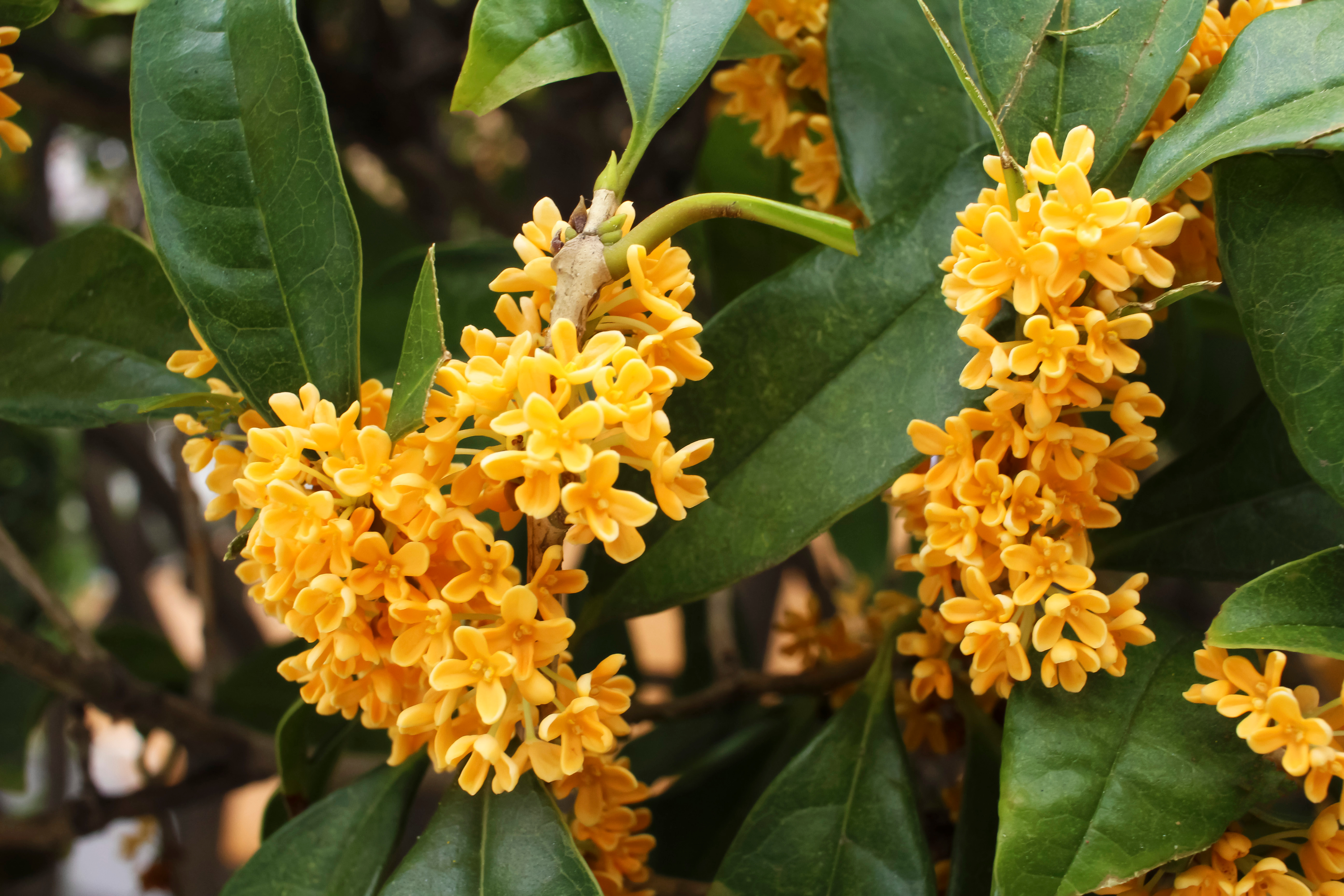Sweet osmanthus
(Osmanthus fragrans)

Description
Osmanthus fragrans (lit. "fragrant osmanthus"; Chinese: 桂花, guìhuā, and 木樨, mùxī; Cantonese Yale: gwai fā; Japanese: 木犀, mokusei; Hindi: सिलंग, silang), variously known as sweet osmanthus, sweet olive, tea olive, and fragrant olive, is a species native to Asia from the Himalayas through southern China (Guizhou, Sichuan, Yunnan) to Taiwan and southern Japan and southeast Asia as far south as Cambodia and Thailand. In China, it is the "city flower" of the cities of Hangzhou, Suzhou, and Guilin. In Japan, it is the "city tree" of Kitanagoya, Aichi Prefecture, and the "town tree" of Yoshitomi, Fukuoka Prefecture. It is an evergreen shrub or small tree growing to 3–12 m (9.8–39.4 ft) tall. The leaves are 7–15 cm (2.8–5.9 in) long and 2.6–5 cm (1.0–2.0 in) broad, with an entire or finely toothed margin. The flowers are white, pale yellow, yellow, or orange-yellow, small, about 1 cm (0.39 in) long, with a four-lobed corolla 5 mm (0.20 in) diameter, and have a strong fragrance; they are produced in small clusters in the late summer and autumn. The fruit is a purple-black drupe 10–15 mm (0.39–0.59 in) long containing a single hard-shelled seed; it is mature in the spring about six months after flowering. Osmanthus fragrans in full bloom (October) in Jingjiang, China It is cultivated as an ornamental plant in gardens in Asia, Europe, North America, and elsewhere in the world for its deliciously fragrant flowers which carry the scent of ripe peaches or apricots. A number of cultivars have been selected for garden use, with varying flower colors. Within Japan, the white- and orange-blossoming subspecies are distinguished as ginmokusei (銀木犀, lit. "silver osmanthus") and kinmokusei (金木犀, lit. "gold osmanthus"), respectively. In Chinese cuisine, its flowers may be infused with green or black tea leaves to create a scented tea (桂花茶, guìhuāchá). The flowers are also used to produce osmanthus-scented jam (t 桂花醬, s 桂花酱, guìhuājiàng), sweet cakes (桂花糕, guìhuāgāo), dumplings, soups, and liquor. Osmanthus jam is used as an ingredient in a type of gruel called chátāng (茶汤), which is made from sorghum or millet flour and sugar mixed with boiling water. This dish is associated with the northern city of Tianjin, although it may also be found in Beijing. In some regions of North India, especially in the state of Uttarakhand, the flowers of sweet osmanthus are used to protect clothes from insects. In traditional Chinese medicine, osmanthus tea has been used as an herbal tea for the treatment of irregular menstruation. The extract of dried flowers showed neuroprotective, free-radical scavenging, antioxidative effects in in vitro assays. From the occasion of its blossoming, the sweet osmanthus is closely associated with the Chinese Mid-Autumn Festival. Osmanthus wine is a traditional choice for the "reunion wine" drunk with one's family, and osmanthus-flavored confections and teas may also be consumed. Chinese mythology held that a sweet osmanthus grows on the moon and was endlessly cut by Wu Gang: some versions held that he was forced to cut it every 1000 years lest its luxuriant growth overshadow the moon itself, others that he was obliged to cut it constantly only to see it regrow an equal amount every day. In late imperial China, the osmanthus was also associated with the imperial examinations, which were held in the 8th lunar month. The chengyu "pluck osmanthus in the Toad Palace" (蟾宫折桂, Chángōng zhé guì) was a refined paraphrase for "passing the exam", in part since one would attract hangers-on as if he smelled as sweet as osmanthus thereafter. "Breaking the osmanthus twig and mounting the dragon" was another euphemism, in this case, for sex.
Taxonomic tree:







